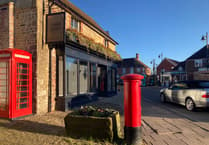Making the journey from London to Portsmouth along the A3 is generally smooth and fast — partly thanks to the Hindhead Tunnel, which opened in 2011.
Built to bypass the village of Hindhead and solve a notorious traffic bottleneck, the 1.14-mile tunnel eliminated the final stretch of single carriageway on the A3.
Many would agree that its opening transformed commutes, boosted local business, and restored peace to a once-congested stretch of road.
But 20 years ago this week, the project was anything but smooth.
In fact, in August 2005, political controversy and public frustration boiled over after the Government refused to release the findings of a major public inquiry into the tunnel’s construction.
The delay sparked fury-filled headlines — and one memorable outburst.
The public inquiry into the £200 million Hindhead Tunnel scheme had concluded earlier that year, in February 2005, following almost six months of debate.
Submissions came from barristers, campaigners, local authorities, residents, and environmental groups, all arguing either for or against the scheme that aimed to solve Hindhead’s 30-year traffic problem.
Opponents of the tunnel, led by a pressure group called STOAT (Save The Old A-Three), feared the environmental cost. They raised concerns about the tunnel’s impact on wildlife, landscape, and noise levels in a site of special scientific interest.
Others, however, saw the tunnel as a vital lifeline that would bring tourism and economic growth back to Hindhead, a village then choking on through-traffic.
After hearing months of arguments, government inspector Alan Gray was tasked with reviewing the evidence and making recommendations. His report would go to Transport Secretary Alistair Darling and Deputy Prime Minister John Prescott, who would make the final decision.
The report was initially expected in June, then pushed back to July. But by August 5, 2005, it had still not materialised, the result, in part, of Mr Gray falling ill.
Even so, the delay triggered mounting anxiety, and the Liphook Herald reported that week there was “outrage” at the “secrecy.”
East Hampshire District Councillor Ferris Cowper was among those demanding answers.
“How can it be fair or just for the people who could be seriously blighted by the decision to be the last to find out what the decision is?” he asked.
“The Government talks about open and accessible government, but here we are wanting a bit of openness, and accessibility and it has brought the shutters down.”
Liphook’s Hampshire County Council representative Sam Jones went even further.
“I cannot understand why the result of the inspector’s inquiry cannot be made public,” he bemoaned.
“There is absolutely no reason why Mr Prescott needs to tuck this report into his shorts and not let anybody else see it.”
He added: “Although nothing surprises me any more about what this Labour government will do.”
And in an appeal to speed up the decision, he said: “Please let’s have the tunnel built to avoid the queues that turn Rectory Lane into a Brands Hatch in the summer.”
Jeremy Hunt, then a newly elected Conservative MP for South West Surrey, was also among those calling for transparency.
After submitting a Freedom of Information request in a bid to see the report, he said he was still being blocked from accessing it.
Mr Hunt said he would be tabling a parliamentary question to identify if the report exists to find out “precisely what the Government intends to do.”
“I am concerned that we went through a public inquiry for it to be buried in bureaucracy,” he said.
Eventually, the report was released and the tunnel got the green light. Construction began in 2007, and it opened to traffic in July 2011.
Today, it’s easy to forget the long delays, fierce objections, and sharp political exchanges that once defined the Hindhead Tunnel.
But back in 2005, the only thing longer than the traffic jams was the wait to see what the Government would do — and where exactly that report was hiding.





Comments
This article has no comments yet. Be the first to leave a comment.